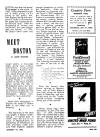
Home Page Meet Boston Menu Index
|
MEET BOSTON Friday, January 16, 1942 in What's New In Town W. J. Sidis |
Boston had the first actual newspaper in the world. In 1688, it was attempted to get out a sheet giving news events to the public; but, New England being then temporarily under a dictatorship, the paper was suppressed after the first issue. After the dictatorship of Andros was overthrown, the news-bulletin idea was revived. In 1704, the Boston News Letter was issued weekly, a four-page paper giving news without commentary. It was printed at a press on Franklin Avenue (named after the editor) and issued through the post office, which then occupied the present site of the Globe. Another Franklin, a younger brother of the News Letter’s editor, carried the idea to Philadelphia some time later. There had previously been periodicals in Europe, but they were literary productions, not newspapers. Boston introduced the news periodical.
*
More daily newspapers in English are issued in Boston than in any other city in America.
*
The liberation of the slave was largely a Boston undertaking. It started back in 1634, when the General Court of Massachusetts resolved that all inhabitants are free; and then, under pressure from England adopted enough exceptions to nullify the resolution. After the Revolution, our Supreme Judicial Court in 1865 interpreted the Massachusetts Bill of Rights as completely abolishing slavery, making Massachusetts the first place to take such a stand, and the only state to declare complete abolition before 1865. In the 40’s and 50’s of the last century, Boston acquired a large colony of fugitive slaves, well defended by the people through Boston “aristocrats” were violently aiding the opposite side in defense of their investments in cotton. The chief abolitionist paper, “The Liberator,” was published by Garrison in Boston at the site of the old Hornblower & Weeks building near Post Office Square. His Roxbury residence―at 125 Highland Street―is still standing. The following inscription can be seen at the site of the paper:
| “In a small chamber, friendless and unseen, Toiled o’er his types one poor unlearned young man. The place was dark, unfurnitured, and mean, But there the freedom of a race began.” |
*
After the famous John Brown uprising at Harper’s Ferry, one of John Brown’s sons took refuge on Walnut Street in Brookline, and continued work on the “underground railroad,” smuggling slaves out of the country.
*
Milton broke away from Dorchester in the 17th century. In 1804, Dorchester Neck was transferred to Boston, and became South Boston. In 1860, Dorchester itself got annexed to Boston, and only Milton remained independent, out of all of Dorchester’s original territory.